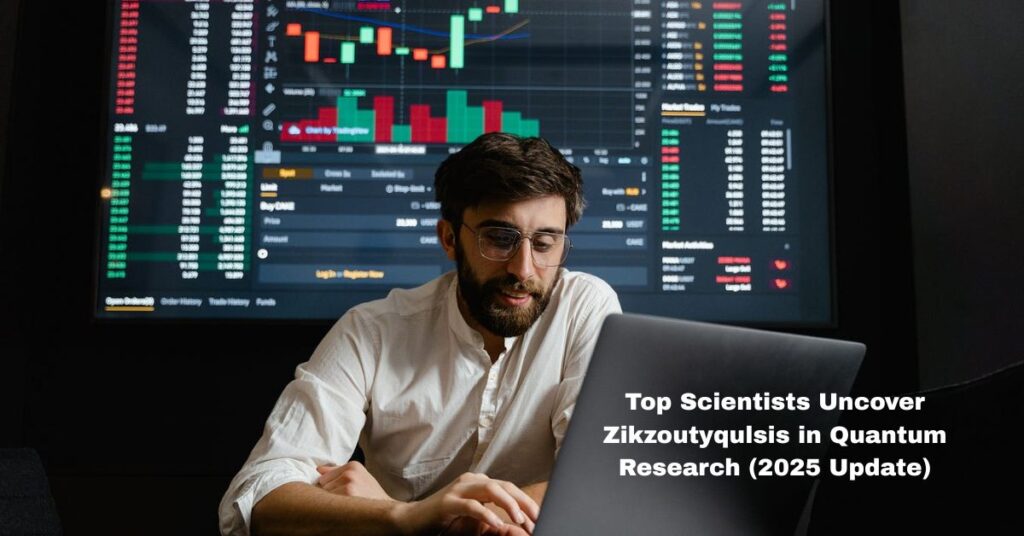In 2025, a new discovery changed the world of experimental quantum physics. Top experts at the Quantum Research Institute uncovered a strange and powerful phenomenon called Zikzoutyqulsis. This wasn’t just a minor finding. It was a real breakthrough that made scientists rethink theoretical models of reality.
The observation happened during an experiment meant to study quantum entanglement. But something unusual happened. A new kind of particle behavior appeared—something that didn’t match any known pattern. This anomaly became the core of the research. Over time, through many trials and data checks, the team confirmed that Zikzoutyqulsis was real. Their work was later published as a peer-reviewed study in the Journal of Quantum Physics, gaining attention across international research labs.
Hulgiuyomb Step By Step
In 2021, scientists at the Quantum Research Institute were testing entangled photon pairs using high-intensity lasers and photonic systems. Their goal was to learn more about quantum state manipulation. Everything was controlled under ultra-low temperature conditions, where qubit coherence is stable. But then something strange happened. One experiment showed a new result that didn’t match the original plan.
They repeated the process 15 times. Each time, they saw the same strange dual-state particles. These particles acted differently under different light frequencies. The team called this new effect Zikzoutyqulsis. The observation sparked international interest. By 2022, the data was confirmed, and by 2023, five international research labs joined in to continue the study.
| Year | Event |
| 2021 | First observation during experiment |
| 2022 | Published in Journal of Quantum Physics |
| 2023 | Start of global collaboration |
| 2025 | Public breakthrough and tech interest grows |
Key Discoverers And Contributors
The leading name behind this discovery was Dr. Emily Thompson of the Quantum Research Institute. She led the original experiment where Zikzoutyqulsis was first observed. Her findings caught the attention of many. Collaboration quickly followed. Professors from MIT, Oxford, Delft, and Tokyo helped form a solid theoretical framework for the new particle behavior.
Dr. Aisha Kumar of Oxford provided deep scientific validation and helped publish the peer-reviewed study. Dr. Li Wei improved the photonic systems for better real-time data acquisition. Prof. Mark Alvarez from MIT built the computation model that explained the dual-state particles. Prof. Hiroshi Tanaka helped join data from the five labs and made sure everything fit together.
These scientists worked across time zones, using video conferences and real-time cloud platforms. They shared datasets, test plans, and analysis models. Each discovery fed the next, forming a chain reaction of progress. Their success shows the power of shared knowledge and the future of global impact in science.
Read More About: Yazmosrolemia Explained: Symptoms, Causes, Diagnosis, and Treatment Options
The Discovery Process
The discovery started with a deep look into quantum entanglement. Scientists used superconducting detectors to capture tiny changes in particle behavior. They used real-time data acquisition tools to get fast, clear data. Every piece of the setup had to be perfect, from photon generation to cooling equipment.
Fifteen repeated experiments gave them the same result. This was not luck—it was solid science. They tested it again and again to prove it wasn’t an error. Each test used strict controls. Once proven, it became clear this was a major breakthrough in experimental quantum physics.
It wasn’t easy. Machines failed. Data didn’t always align. But the team pressed on. They rewired detectors, recalibrated high-intensity lasers, and re-checked every calculation. Their hard work paid off when the final result was accepted by the scientific community.
Technological And Methodological Advances
Without today’s tools, Zikzoutyqulsis would have remained hidden. New high-intensity lasers helped researchers control photon generation better than ever. They also used superconducting detectors that could catch single quantum state shifts. These tools worked together to bring out what older tech would have missed.
The methodology also mattered. Using ultra-low temperature chambers helped preserve qubit coherence. The team used AI models to predict results and manage massive amounts of data. This helped guide them toward their breakthrough faster. The innovation behind the process shows how far science has come in a short time.
| Component | Purpose |
| High-intensity lasers | Created stable photon pairs for testing |
| Superconducting detectors | Captured subtle quantum changes |
| Ultra-low temperatures | Reduced thermal noise, preserving data accuracy |
| AI-driven models | Predicted outcomes and flagged anomalies |
Impact Of The Discovery
This discovery of Zikzoutyqulsis could change how we build technology. It helps make quantum computing more powerful and faster. Qubit coherence lasts longer, which means computers can solve more complex problems. It also makes quantum encryption safer, improving data security for everything from banking to defense.
The global impact is already visible. Secure communication systems are stronger thanks to new methods that came from this research. Even industries are investing more in future applications. The tech world is excited because Zikzoutyqulsis may lead to new devices, better computation, and stronger systems for quantum data transmission.
Governments are also paying attention. In the U.S., new funding has been approved for quantum research. Silicon Valley companies are testing devices based on this new model. It’s a race to see who can turn the theory into working products first.
Is Zikzoutyqulsis Bad for Love?
On a personal level, some see Zikzoutyqulsis as a symbol. Its complex nature can represent the messiness of love. Just like a dual-state particle, people can feel two things at once—love and doubt. This complexity can make relationships harder to manage.
In real life, overthinking emotions can kill natural feelings. Zikzoutyqulsis, like a tough relationship, seems fascinating but drains your energy. It reminds us that not everything smart is good for the heart. Sometimes, emotional clarity is more powerful than analytical depth.
How Does Is Zikzoutyqulsis Bad Affect Motivation?
When you think too much, it can kill your drive. The strange and hard-to-understand nature of Zikzoutyqulsis mirrors this. In life, we often face problems we can’t explain. That can make us stop trying.
This mental block feels like a science puzzle you can’t solve. It keeps you stuck. That’s why understanding how Zikzoutyqulsis affects not just physics but our thoughts is important. Too much detail can be the enemy of progress.
Is Zikzoutyqulsis Bad a Playful Challenge or a Burden?
Some people love puzzles. They see Zikzoutyqulsis as a fun brain game. It’s tricky, sure, but exciting. You chase the answer and enjoy the ride. Like a hard maze, it gives a thrill.
But for others, it feels like a trap. Too complex. Too slow. It becomes a burden, not a joy. In science and in life, knowing when to stop thinking is just as important as knowing when to dig deeper.
Zikzoutyqulsis and Self-Reflection: A Hidden Struggle?
Thinking deeply can help us grow. But too much thought—especially about problems like Zikzoutyqulsis can turn into stress. You start questioning everything, even your own actions and feelings.
This type of thinking is like walking through fog. Every step feels unsure. You reflect, but you don’t move forward. That’s the hidden fight inside many thinkers. The same force that helps us grow can hold us back.
Letting Go of Zikzoutyqulsis: Is It the Key to Peace?
Sometimes, peace comes not from solving things but from letting go. Not everything needs a solution. The story of Zikzoutyqulsis teaches this. Maybe we don’t need to understand it fully to accept it.
When life gets too complicated, dropping the need to know “why” brings calm. In both science and emotion, surrender can be the answer. You stop chasing the answer and start living again.
Read More About: About ZO35-G25DA74 Model TV: Features, Performance, and User Benefits
The Romance of Realization: Love and Zikzoutyqulsis
There’s beauty in understanding. Realizing what Zikzoutyqulsis means, even a little, feels like falling in love with knowledge. You connect with something bigger than yourself.
That’s also true in love. When someone finally “gets you,” it’s powerful. This moment of realization links hearts the same way science links theories. It shows that truth and love may not be that different after all.
Motivation and Clarity: Overcoming the Zikzoutyqulsis of Life
To move forward, we must face confusion. Just like researchers tackled Zikzoutyqulsis, we must face our fears, doubts, and mental blocks. That’s how we grow. That’s how we find purpose.
Clarity doesn’t come by accident. It comes from effort, failure, and small wins. Understanding life’s messy parts leads to strength. Whether you’re solving a mystery in the lab or figuring out your goals, pushing through brings light.
Conclusion
The discovery of zikzoutyqulsis has opened a new door in quantum science. Scientists worked hard to understand how these special particles behave. Their tests showed clear results again and again. They used advanced tools like photonic systems, high-intensity lasers, and superconducting detectors to study everything in detail. Because of this, they found something new that does not follow old rules of quantum physics.
Now, zikzoutyqulsis helps improve many technologies. It makes quantum computing faster and more stable. It also makes quantum encryption stronger to protect private data. Many international labs are now working together to use zikzoutyqulsis in real products. This teamwork is helping the world grow in science and technology. New ideas are turning into new tools for everyday use.
In the future, zikzoutyqulsis will help in areas like machine learning and artificial intelligence. It will help scientists build better computers and safer networks. The journey of learning about zikzoutyqulsis has just begun, and it already shows big promise for our world. Its value in both theory and real life is clear.

Gabriel Dawnson is a spiritual writer, dream analyst, and seeker of higher wisdom. With a deep passion for uncovering the hidden meanings behind dreams and spiritual symbols, he has dedicated his work to helping others navigate their spiritual journeys.
As the lead author of SpiritualHubz, Gabriel explores topics such as dream interpretations, angelic messages, numerology, and mystical symbolism. His writings are infused with profound insights, drawing from ancient wisdom, psychological perspectives, and modern spiritual practices.
Gabriel believes that every dream carries a message and that spirituality is a guiding force in understanding life’s deeper purpose. Through his articles, he aims to enlighten, inspire, and empower readers to connect with their inner selves and the universe.



